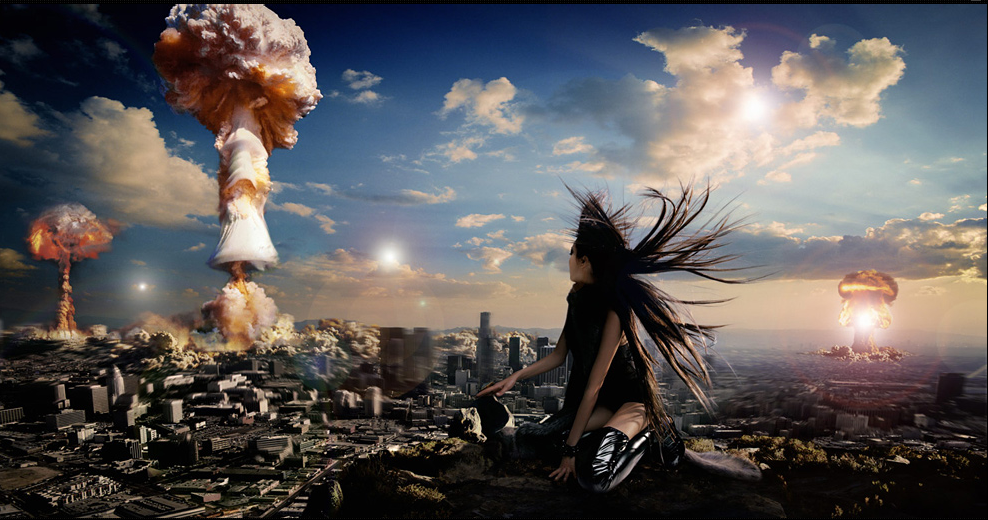John posts semi-regularly at BAGnewsNotes.com and occasionally we will double-post or link the posts here at NCN. This post appeared initially at the BAG yesterday. We encourage you to check in to see the comments it has evoked there.
************************************************
Anxiety over nuclear bombs is perhaps more pronounced today than anytime since the Cold War, marked by a persistent worry about unfriendly nations, renegade scientists, and terrorists of all stripes gaining access to enriched uranium and nuclear warheads. And yet, outside of a few editorial cartoons here and there, images of “the bomb” are missing in action. For all the talk of nuclear terror, you might expect to see the image of the explosion at Nagasaki or any of the hydrogen bomb explosions obliterating Pacific atolls. These were a staple of the Cold War era, but despite other similarities with the War on Terror, they are not to be seen.
At least that was the case until late last year when this image appeared on the front page of the NYT website as the anchor to a story about the debut of the 2007 Miami Beach Art Expo titled “Work With Me Baby.”
The photograph, created by fashion photographer (and music video director) Seb Janiak, clearly puts “the bomb” back in the public eye, but it does so in a manner that functions as an artistic challenge to the prevailing optic of the Cold War image of the bomb. The Cold War optic relied upon a logic of absence (there was no destruction to be seen, just the explosion in all of its grandeur), the formal perfection of the “mushroom cloud” (the explosion cast in terms of abstract symmetry), and it operated under the complete control of a technologically sophisticated. military-industrial complex (only with such access could one get close enough to take such pictures, whether from 35,000 feet or in the Marshall Islands).
In place of the structured absence, the target of destruction is now evident as we witness the immolation of an actual city (Los Angeles). The formal perfection of the explosions is retained in some measure, but notice that the affect is different: the cool, richly saturated blue sky dotted with puffy white cumulous clouds stands in stark opposition to the cold war optic. Where before one saw either high contrast black and white photographs which underscored the abrupt and violent disruption of the force of the bomb or color photographs heavily overcast in dominating red and orange hues which signified the overwhelming heat of the blast, now we’re in the artificial colors of a tourism postcard. Finally, the three explosions operate outside of the closed circuit of military control. Indeed, these would appear to be tactical nukes, precisely the kind that we imagine being smuggled into our cities by terrorists.
The key point, of course, is that the Cold War nuclear optic with its formal perfection and modernist abstraction is no longer adequate (if it ever was) to the potential problems we face. And yet those problems have not gone away for the absence of a compelling image (just as the problem of torture at Abu Ghraib was no less serious before photographs turned our attention to it). And so what is the newer optic we are being offered and what are its implications?
The question for us has to be, what’s going on here? In one sense the image is a step forward as it challenges both the image culture of the Cold War and the apparent cultural amnesia that has lately erased images of the mushroom cloud from the public’s optical consciousness. And yet, the alternative that it offers as a primary replacement seems to draw from the world of high fashion, a point underscored by the title of the article that the photograph anchors, “Work With Me, Baby.” These are the words of avant garde fashion photographers working fast and furious to capture a soft porn aesthetic that can be published in magazines suitable for middle class consumption. And so, one has to wonder, is this image one step closer to Walter Benjamin’s terrible prophecy that our “self-alienation has reached such a degree that it can experience its own destruction as an aesthetic pleasure of the first order?” Or is it a cautionary tale designed to warn us against our own cultural indifference? After all, it is really unlikely that fashion models will really save us from ourselves, let alone from the atrocities likely to erupt from the technologies of war.

[…] Post cold war nuclear opticAnxiety over nuclear bombs is perhaps more pronounced today than anytime since the Cold War. And yet, outside of a few cartoons here and there, images of âthe bombâ seem to be missing in action. At least until late this image appeared Submitted: 3 minutes ago Category: Images Submitter: RssFeed Website: http://www.nocaptionneeded.com Report this link: Click here to report Comments: 0 […]
[…] Post Cold War Nuclear Optic […]